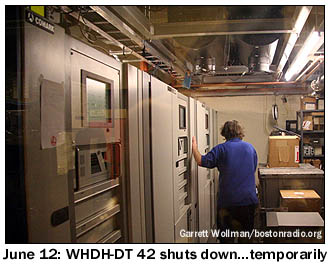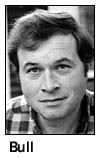|
June 22, 2009
VHF in the Spotlight
*Back
in the age of analog TV, the conventional wisdom held that the
low-band VHF spectrum - TV channels 2-6 - would become superfluous
as soon as the digital transition was over. Electrical noise,
propagation anomalies and the need for large, usually outdoor,
receiving antennas would make those channels undesirable for
digital TV, eventually freeing them up for other, non-TV, uses...or
so the belief went.
As we enter the second full week of the digital TV era in
the U.S., that conventional wisdom is being confirmed by some
established stations, as problems crop up with VHF digital TV
not only on the low band but on the high-band channels (7-13)
as well. But it's also being significantly challenged by some
newcomers, including one broadcaster who's found a loophole that
may put new full-power DTV stations on the air in the New York
and Philadelphia markets at a bargain price.
The problems, first: No sooner had stations such as Boston's
WHDH-TV (Channel 7), Philadelphia's WHYY-TV (Channel 12) and
New York's WABC-TV (Channel 7), WPIX-TV (Channel 11) and WNET
(Channel 13) made the move from their pre-transition digital
channels to digital operation on their old analog channels than
the complaints started pouring in: viewers who'd had no trouble
with DTV on the UHF dial were finding it difficult or impossible
to get a lock on the relatively low-powered VHF signals.
While many were no doubt using the UHF-only compact antennas
that dominated the marketplace of "digital antennas"
in the first few years of the transition, problems were being
reported even by technically-adept viewers using decent VHF antennas.
And as bad as things were for those high-band VHF stations,
they were even worse for the largest station in the nation to
elect a spot on the low VHF band, ABC's WPVI (Channel 6) in Philadelphia,
where phone lines and message boards were flooded with complaints
from viewers who could see everything in town except ABC.
 For
some of the affected stations, solutions - temporary ones, at
least - were as close as the next room in the transmitter building.
On Tuesday, WHDH received special temporary authority from the
FCC to reactivate its interim channel 42 digital signal, and
there's word that the station is now trying to resolve some spacing
issues in order to make its permanent home on UHF. (That's still
not an inexpensive solution; WHDH spent considerable money and
manpower to install the VHF digital rig that could end up being
turned off after just a few weeks on the air.) For
some of the affected stations, solutions - temporary ones, at
least - were as close as the next room in the transmitter building.
On Tuesday, WHDH received special temporary authority from the
FCC to reactivate its interim channel 42 digital signal, and
there's word that the station is now trying to resolve some spacing
issues in order to make its permanent home on UHF. (That's still
not an inexpensive solution; WHDH spent considerable money and
manpower to install the VHF digital rig that could end up being
turned off after just a few weeks on the air.)
For other stations, such quick fixes weren't an easy option.
WPVI, WHYY, WNET and other VHF digitals in the region (Rochester's
WHEC-TV and WHAM-TV, Lancaster's WGAL, Manchester's WMUR) were
using digital channels in the upper UHF band that's now outside
the broadcast spectrum. WPIX's former channel 33 digital allocation
is now home to another station, WCBS-TV. And WABC-TV's former
channel 45 has spacing issues that would make it less than desirable
for permanent use.
Fortunately, the FCC was quick to issue additional STAs for
power increases. WPVI, for instance, was able to crank its power
from 7.5 kW to 30 kW by the weekend, resulting in at least a
moderate increase in its receivability. In the long run, though,
it appears the FCC may be right back where it was in, say, 1950:
coming to terms with the reality that the state of the art in
receiver and antenna design probably requires significantly more
power than was originally thought necessary.
That, too, may be an expensive solution for some stations
that had already built what were to be their "permanent"
VHF digital facilities - though the good news is that most of
the stations moving back to their VHF analog allocations have
plenty of headroom in their antennas and transmission systems
for more power, and often have extra transmitter power to spare,
too, if they've converted recent analog transmitters to digital
use.
*In the meantime, though, those "vacated" channels
at the bottom of the TV dial may fill up faster than expected
in some big markets.
We've already reported on the surge in demand from low-power
TV stations for new berths on channel 6, where continued analog
LPTV operation makes it possible to function as pseudo-FM stations
on 87.7. In some cities, other newly-vacated low-VHF channels
are being filled by LPTVs as well; for instance, WNYW's now-former
channel 5 slot in New York already has a digital LP construction
permit for a new occupant.
Full-power use of those vacated channels, though, was supposed
to be far in the future, if it happened at all, since the FCC
is apparently in no hurry at all to thaw the long-frozen allocations
table to allow for new digital-only allotments. But when there's
a huge prize to be had - signals over two of the nation's largest
TV markets - there's no underestimating how far the creativity
of a good communications lawyer can go toward finding an unusual
way to shoehorn new stations onto the dial.
 That's the long way
around to explaining why NEW JERSEY's Press Communications
quietly bought two tiny TV stations out west - NBC affiliate
KJWY (Channel 2) in Jackson, Wyoming and independent KVNV (Channel
3) in Ely, Nevada - and why it's apparently poised to move those
stations right into the heart of the Philadelphia and New York
TV markets, respectively. That's the long way
around to explaining why NEW JERSEY's Press Communications
quietly bought two tiny TV stations out west - NBC affiliate
KJWY (Channel 2) in Jackson, Wyoming and independent KVNV (Channel
3) in Ely, Nevada - and why it's apparently poised to move those
stations right into the heart of the Philadelphia and New York
TV markets, respectively.
The loophole that makes those moves possible dates back a
quarter of a century, to the mid-80s controversy over the lack
of local TV presence in both New Jersey and Delaware. An amendment
to the Communications Act of 1933 established a way for states
with no commercial VHF stations - a list that included only New
Jersey and Delaware - to gain such operations: it provided that
any licensee that notified the FCC that it was willing to accept
reallocation to a VHF-less state would immediately be granted
a license for the moved operation, bypassing just about every
other provision of the Act except for spacing requirements.
The provision was very narrowly targeted, aimed entirely at
moving New York's WOR-TV (Channel 9) to Secaucus, N.J., a move
owner RKO accepted in order to be allowed to sell the station
instead of losing the license as part of the investigation into
RKO's billing practices. But long after channel 9 made the move
- and long after it was clear that the "move" didn't
prevent channel 9, now WWOR, from continuing to be a "New
York" station, transmitting from Manhattan and serving the
entire metro area - the rule stayed on the books, apparently
never to be used again.
With the DTV transition looming, though, the lawyers at Fletcher,
Heald and Hildreth spotted an opportunity: since WWOR's digital
signal is on channel 38, New Jersey would end up once again bereft
of VHF stations. With the channel 2 stations in New York City
and Baltimore vacating that spot, and channel 3 in Philadelphia
and Hartford going empty as well, there was suddenly spectrum
available for VHF allotments in both New Jersey and Delaware...and
a law on the books that appeared to give that spectrum to any
station willing to make the move, just for the asking.
And so Press notified the FCC last Monday that it was "willing
to accept" reallocations that would move KJWY's channel
2 from Jackson to Wilmington, Delaware, and KVNV's channel 3
from Ely to Middletown Township, New Jersey - with strongly-worded
language making it clear that it believes the Commisson is compelled
by the language of Section 331(a) of the Communications Act to
immediately grant those moves.
It should come as no surprise, of course, that the new "Delaware"
and "New Jersey" stations would have their sights set
on the bigger markets next door: Channel 2 would transmit with
10 kW/845' from the Roxborough tower farm in Philadelphia, while
Channel 3 would have 10 kW/860' from the Four Times Square tower
in Manhattan, making both signals full-market (within the limitations
of low-band VHF) in their respective markets.
What's in it for the people of Delaware and New Jersey? Probably
not all that much: in a Delaware newspaper interview, Press CEO
Bob McAllan (the managing member of "PMCM, LLC," the
licensee of KJWY and KVNV) wouldn't even go so far as to commit
to local studios in either state, promising only that the stations'
programming, once moved, "might be something you haven't
seen before." Given the FCC's current lax requirements for
local news - and the lack of a requirement for a main studio
in the city of license, a rule that at least obliged WWOR to
move its studio from Times Square to Secaucus back in the day
- it appears, to us at least, that there's little to stop the
new channel 3 and channel 2 from setting up shop right in Manhattan
and Philadelphia, respectively, yielding new stations in those
cities at an amazing bargain price: PMCM paid just $1.2 million
for those two licenses in Nevada and Wyoming, and surely far
less than that for the legal work to get the stations moved.
The big question, then, is whether the FCC will indeed grant
the moves. We're not lawyers here - but our reading of Section
331(a) suggests that the Commission would have a hard time saying
no. Unless Delaware and New Jersey get VHF allocations some other
way - say, by WPVI or WABC or WPIX trading their VHF allotments
to commercial broadcasters on UHF in Delaware or New Jersey,
a prospect that seems unlikely - the FCC appears to be required
to do just what PMCM says it must, though of course there's nothing
saying they have to hurry up about it. And while the FCC is loath
to set precedents like this, it appears to us that there's no
precedent to be set: once the KJWY and KVNV moves are granted,
there would be no states without VHF commercial stations (meaningless
though that distinction is in the channel-mapped DTV world),
and thus no further application of Section 331(a) - so perhaps
the FCC will be inclined to simply get these two moves over with.
As always...stay tuned.
 *One
more note about DELAWARE TV: Wilmington-licensed WHYY-TV
(Channel 12) announced last week that it's pulling the plug on
the nightly "Delaware Tonight" newscast that it's long
produced as a concession to its nominal city of license. *One
more note about DELAWARE TV: Wilmington-licensed WHYY-TV
(Channel 12) announced last week that it's pulling the plug on
the nightly "Delaware Tonight" newscast that it's long
produced as a concession to its nominal city of license.
The station, which has been based in Philadelphia for decades,
says it will retain a small news crew in Wilmington, but will
sell its studio there and close its news bureau in the state
capital, Dover.
*The rest of our PENNSYLVANIA news
this week starts on a sad note: five years into his fight with
prostate cancer, WPVI (Channel 6) sports director Gary Papa,
a beloved figure on the Philadelphia airwaves, died Friday at
age 54.
Papa was a native of Buffalo, where he grew up with his brother
Greg, now the play-by-play man for the Oakland Raiders. He started
his career at WSTV-TV (Channel 9, now WTOV) in Steubenville,
Ohio, then returned to Buffalo to do sports at WGR-TV (Channel
2, now WGRZ) before joining the WPVI Action News team in 1981.
 He had
been sports director there since 1990, though he'd been on the
air only sporadically in recent months as his illness worsened.
One of his last public appearances came on April 13, when he
appeared in a wheelchair for the memorial service for longtime
Phillies broadcaster Harry Kalas. He had
been sports director there since 1990, though he'd been on the
air only sporadically in recent months as his illness worsened.
One of his last public appearances came on April 13, when he
appeared in a wheelchair for the memorial service for longtime
Phillies broadcaster Harry Kalas.
In addition to his brother and parents, Papa is survived by
his wife, Kathleen, and two sons.
*At the other end of the Keystone State, public broadcaster
WQLN TV/FM made some big staff cuts last week as it tries to
cope with the apparent elimination of the $800,000 it received
annually from the state.
Five staffers, including PD Gordon Stroufe and CE Ed Upton,
lost their jobs, and the rest of the WQLN staff is taking pay
cuts (10% for top management, 5% for others) and facing two-week
unpaid furloughs. In addition, WQLN-FM (91.3) is dropping the
syndicated "Marketplace" from its evening schedule.
*Jim Conlee is the new midday man at Steel City Media's WLTJ
(92.9 Pittsburgh), joining "Q92.9" (are they ever going
to change those calls?) after several years out of town in Houston
and San Antonio, Texas.
Down the road at WZUM (1590 Carnegie), $800,000 is the sale
price as the station prepares to change hands from Sovereign
City Radio Services to Katrina Chase's Believe & Achieve
Family Educational Center, which is already LMA'ing the station
and running a black gospel format on it.
*One more piece of NEW JERSEY news - the simulcast
of ESPN radio in south Jersey didn't last long: while WENJ-FM
(97.3 Millville) carries the Worldwide Leader in Sports in English,
WENJ (1450 Atlantic City) has flipped to its Spanish-language
sister, ESPN Deportes.

DO IT RIGHT PRODUCTIONS --
Visit our Web site, doitrightproductions.net,
to hear our three syndicated shows, Classic Clips, Country Roots
and Gospel Doings, produced by longtime country and bluegrass
lovers. We also provide demo and duplicating services. Contact
Roland (Bruce) Cutler, PO Box 351, Lyons, NY 14489; or dirp650@verizon.net.
I'M YOUR GUY! I'm passionate about radio that's a
part of the community and I love meeting listeners because I
TRULY care about being LIVE and LOCAL. With 5 years in radio,
I'm good with technology and I'm just a regular hard working,
honest guy. I'm looking for a radio station to call home. Email
aradiojob@gmail.com
for resume & demos.
You can have
your ad here, for just a few dollars a week! Click
here
for information on the most economical way to reach tens of thousands
of Northeast radio and TV people each week. |
 *Our NEW YORK
news starts in Utica, where just a month after Eric Thomas
arrived as the highly-publicized new morning man at Roser's "Kiss
FM" (WSKS 97.9 Whitesboro/WSKU 105.5 Little Falls), he's
parted ways with the station. In an unusually outspoken blog
posting, Thomas called his move from Michigan "one of
the biggest mistakes of my life," and he says the format-flip
stunt that heralded his arrival was not his idea. *Our NEW YORK
news starts in Utica, where just a month after Eric Thomas
arrived as the highly-publicized new morning man at Roser's "Kiss
FM" (WSKS 97.9 Whitesboro/WSKU 105.5 Little Falls), he's
parted ways with the station. In an unusually outspoken blog
posting, Thomas called his move from Michigan "one of
the biggest mistakes of my life," and he says the format-flip
stunt that heralded his arrival was not his idea.
"Kenny the Promo Guy" is handling mornings on Kiss
on a temporary basis while the station looks for a replacement,
and while Thomas looks for new work.
Meanwhile, on a hill in the town of Floyd, north of Utica,
there's a fight brewing between EMF Broadcasting's WOKR (93.5
Remsen) and a neighbor who claims that the station's new antenna
location is putting so much RF over his nearby home that it's
causing him and his family to break out in blisters and suffer
other illnesses.
Steve Lloyd told the Utica Observer-Dispatch last week
that he was forced to move from his house adjacent to the tower
not long after WOKR signed on there in mid-April, and to back
up his claims he showed the newspaper a report from an engineering
firm claiming that the 3-kW signal operating from a 2-bay antenna
85 feet above the ground was making it unsafe to be in his house
for more than 30 minutes a day.
But as the story drew national attention in the engineering
community, some questions developed - especially after Utica's
WKTV reported that the engineering company that allegedly prepared
the report is denying having done so. (The newspaper had reported
that Mid-State Communications prepared the report "at Lloyd's
request"; Lloyd told WKTV "he was given the study.")
Town officials have asked Congressman Michael Arcuri to look
into the matter, and EMF says it's also trying to determine the
source of Lloyd's problems.
*New calls in the Hudson Valley: WGMY (88.1 Montgomery) is
now WNYX. (Extra points if you recall that "WNYX" was
also the fictional station, at 585 on the AM dial, in the 90s
sitcom "NewsRadio"...)
WGMY-turned-WNYX is also being heard on the 106.3 translator
in Poughkeepsie that used to be carrying WDST (100.1 Woodstock)
- and while we're thinking of translators in the Hudson Valley,
we should note that the True Oldies Channel programming from
the HD2 channel of New York's WPLJ (95.5) is reportedly being
heard on several signals up north, including 93.7 in Newburgh,
94.1 in Chester, 94.9 in Middletown and 95.7 in Poughkeepsie.
More new calls upstate: Pax et Bonum, Inc., which was just
granted a CP for 89.9 in Esperance, west of Schenectady, takes
the calls WOPG for the new station. And a new signal on 88.7
in Fleming, near Auburn, takes the calls WTMI, last seen on the
AM dial in Hartford (and before that for decades on FM in Miami.)
*One of the true veterans of the upstate broadcast scene is
about to retire. Jack Mindy, who grew up in a broadcasting family
even before starting his own career while still in high school
in 1957, went on to work at many of the biggest stations in the
region: WSYR, WHEN and WFBL in Syracuse (where he also made a
cameo appearance in the movie "Slap Shot"); WYSL, WBEN
and WWKB in Buffalo and WHAM in Rochester.
More recently, Mindy has been the operations manager and afternoon
jock at WGMC (90.1 Greece), the community jazz station in the
Rochester market - but his July 6 show there will be his last,
as he heads off for a well-deserved retirement.
WGMC has found a highly-qualified replacement for Mindy on
the air: starting July 7, former WGMC station manager Eric Gruner
returns to the air in that 3-7 PM slot.
Across town at public broadcaster WXXI, several veteran staffers
are departing as part of a buyout, including news reporter Bud
Lowell, a 30-year veteran at the station; WXXI-TV program director
Bob Owens and executive director of broadcast production John
Overlan; and operations supervisor Ed Wright.
In Ithaca, WHCU (870) is looking for a news anchor/reporter.
Todd Messner, who's been with the station for about a year, is
leaving in July to get married and move to New Jersey - and that
means the Saga news/talker needs someone who can fill his duties
there, including anchoring the station's 6 PM and Saturday morning
newscasts and nighttime reporting.
*Some personnel moves way up north: Wayne Thompson, late of
CJSS in Cornwall, Ontario, is crossing the St. Lawrence to take
the morning chair at WVLF (96.1 Norwood), where he's now at the
helm of the "Mix 96.1 More Music Morning Show."
And up the road in Potsdam, we're hearing that WSNN (99.3)
and WPDM (1470) are trading their local hosts for satellite-delivered
music.
*On TV, Watertown viewers will soon be seeing some Syracuse
news: beginning tonight, ABC affiliate WWTI (Channel 50) will
carry the 11 PM newscast from sister station WSYR-TV (Channel
9) in Syracuse. For now, that's the only WSYR newscast that will
be seen in Watertown.
Downstate, Verizon is entering the content business with the
launch - apparently sometime today - of its "FiOS 1"
local news/weather/traffic channel in the New York City market.
The new channel will compete with Cablevision's regional News
12 channels in the suburbs and with Time Warner's New York 1
in the city.
|
CLEARANCE
SALE! DON'T WAIT!
 We thought we'd sell out of Tower Site Calendar
2009 without resorting to a clearance sale...but
not quite. We thought we'd sell out of Tower Site Calendar
2009 without resorting to a clearance sale...but
not quite.
Our business manager (aka Mrs. Fybush)
reports that a limited quantity of 2009 calendars are still available
- and as we get ready to send Tower Site Calendar 2010
to the printer, we're clearing out the remaining 2009
editions.
The supply is dwindling fast at our clearance
price of just $9 each, postpaid - that's half-off the
usual price of $18. So place that order now - and get ready for
pre-orders of the 2010 edition, starting in July.
Order
now at the fybush.com Store! |
*The MASSACHUSETTS-based New England
Cable News is getting a new owner - or rather, it's losing one
of its two co-owners, as Comcast buys out Hearst's half-interest
in the regional network. NECN's founding news director, Charlie
Kravetz, who'd been serving as the network's general manager
and president, exited when the announcement was made Thursday,
leaving Bill Bridgen in charge of both NECN and Comcast SportsNet
New England. Some of NECN's business operations are being combined
with CSN New England at CSN's Burlington facility, though NECN
will remain at its Newton headquarters.
 *Two obituaries make up our MAINE news this
week, starting at WKTJ (99.3 Farmington), where PD/sales manager
Steve Bull died suddenly on May 30 after suffering an inoperable
brain aneurysm. Bull had been with the station 28 years, working
in pretty much every imaginable capacity at the station, as well
as writing a newspaper column and running a catering business.
Bull was just 54. *Two obituaries make up our MAINE news this
week, starting at WKTJ (99.3 Farmington), where PD/sales manager
Steve Bull died suddenly on May 30 after suffering an inoperable
brain aneurysm. Bull had been with the station 28 years, working
in pretty much every imaginable capacity at the station, as well
as writing a newspaper column and running a catering business.
Bull was just 54.
And Don Zihlman, who worked as morning host on WLAM (1470
Lewiston) in the early 1980s, died June 12 after a fight with
cancer. After leaving WLAM, Zihlman started a successful marketing
company in the Portland area. He was 61.
*In CONNECTICUT, "nightlight"
operation at WFSB-TV (Channel 3) didn't last long. While the
FCC had WFSB listed as carrying the nightlight loop of DTV conversion
information through June 26, the analog signal disappeared sometime
late Sunday or early Monday, after just over two days of operation.
Over in Bolton, translator W248AB (97.5), which was relaying
Willimantic's WILI-FM (98.3) to the eastern edge of the Hartford
market, is being sold. John Fuller's Red Wolf Broadcasting is
paying Mountaintop Enterprises $100,000 for the translator, which
recently filed to increase power from 10 watts to 60 watts -
and to begin relaying Red Wolf's WMRQ (104.1 Waterbury).
And we remember Michael Bernz (Cipriani),
who had most recently been working weekends at WWLI (105.1) in
Providence, RHODE ISLAND, but who was best known for his
many years in morning drive in New London at WBMW (106.5 Ledyard)
and WCTY (97.7 Norwich).
Bernz died Thursday (June 18) at 58; he's survived by his
parents, his wife, Diane, along with two children and a grandson.
 Edited by NERW's own Scott Fybush - on sale now as
an e-book or printed volume!
Edited by NERW's own Scott Fybush - on sale now as
an e-book or printed volume!
 *CANADA's
latest AM-to-FM move is now underway in Peterborough, Ontario,
where CKRU (980) signed on CKRU-FM (100.5) last Monday. The new
"Greatest Hits Kruz 100.5 FM" continues to simulcast
on AM 980 for the next three months. *CANADA's
latest AM-to-FM move is now underway in Peterborough, Ontario,
where CKRU (980) signed on CKRU-FM (100.5) last Monday. The new
"Greatest Hits Kruz 100.5 FM" continues to simulcast
on AM 980 for the next three months.
TJ Connors is the new morning man at CKRU's sister FM station,
CKWF (101.5 the Wolf), moving there after a few months of mornings
at CKLY (91.9 Bob FM) in nearby Lindsay/Kawartha Lakes.
*CKRU-FM won't be Canada's newest FM station for long: last
week, the CRTC approved the CBC's application to move CBE (1550
Windsor) to FM, using a transmitter in Windsor on 97.5 (19 kW
max DA/427') and another in Leamington on 91.9 (10.5 kW max DA/241').
And out in Nova Scotia, the second time around was the charm
for the Tantramar Community Radio Society, which had been turned
down on its first bid for a community station on 107.9. That
time, Maritime Broadcasting System complained that the new signal
would sap ad revenue from its existing CKDH (900) - but with
CKDH having now been granted its own move to FM, the CRTC determined
this time around that Tantramar's proposed station, with 6.5
kW/403', wouldn't harm MBS' revenues.
|
From
the NERW Archives
(Yup, we've been doing this a long time now, and
so we're digging back into the vaults for a look at what NERW
was covering one, five, ten and - where available - fifteen years
ago this week, or thereabouts. Note that the column appeared
on an erratic schedule in its earliest years as "New England
Radio Watch," and didn't go to a regular weekly schedule
until 1997. Thanks to LARadio.com
for the idea - and thanks to you, our readers, for the support
that's made all these years of NERW possible!)
June 23, 2008 -
- It was a bad week for Cumulus' WRKI (95.1 Brookfield CT),
after a lightning hit on the station's tower knocked its main
signal off the air last Saturday (June 14). Photos of the fire
were the talk of the engineering community early last week, as
the experts pored over the shots of flames erupting from the
top of the tower and speculated on what happened. The answer,
as it turns out, was a melting radome on the lower bay of the
station's two-bay ERI rototiller antenna, and the result was
a damaged antenna and a silent station. WRKI was back on the
air at reduced power by Saturday night, and many listeners never
even noticed the outage, since classic rock "I-95"
reaches the southern half of its Fairfield County listenership
by way of on-channel booster signals in Bridgeport and Norwalk.
Unaffected by the lightning strike, those signals stayed on the
air at full power - and we hear reception was actually a little
better than usual in Stamford, where the boosters and the main
signal usually interfere a bit with each other.
- Also silenced, at least briefly, was sister station WPUT
(1510 Putnam NY), which has its studio-transmitter link on the
tower. It was back on the air early last week, and WRKI returned
to full power at week's end with a new antenna and transmission
line.
- Alert readers may note that this is the second such burning
FM radome in southwestern Connecticut in less than a year - last
September, the antenna of WCTZ (96.7 Stamford) took a lightning
hit and caught on fire as well.
- Emmis has picked a PD for its New York rock outlet, WRXP
(101.9). Leslie Fram comes north from Atlanta, where she's spent
the last 17 years at Cumulus' WNNX (99.7 Atlanta), the last ten
as PD before its "99X" modern rock format was moved
off to an HD2 subchannel earlier this year. At WRXP, she replaces
Blake Lawrence, the last remaining holdover from the station's
previous existence as smooth jazz WQCD.
- Are the star personalities at CBS Radio's top-billing sports
station, WFAN (660 New York) on the way out the door - or just
looking for some love at contract-renewal time? Sunday's Newsday
carried an article speculating that Mike Francesa and Chris "Mad
Dog" Russo may have done their last show together on WFAN.
They've been taking alternating vacations, and they're next scheduled
to be together on July 11. Their contract renewal comes at a
challenging time for WFAN: not only is the station still recovering
from the loss of Don Imus and his sizable ad revenue last year,
but another WFAN cash cow - the New York Mets - are in the last
year of their contract with WFAN, which has been their home ever
since the station signed on in 1987. (On the other hand, given
the general haplessness of the Mets this year, perhaps the team
isn't in the best position for contract renewal either?)
- A big PD vacancy in MASSACHUSETTS has been filled: Mike Thomas,
who's already PD of WZLX (100.7 Boston), adds the same duties
at sister station WBCN (104.1 Boston), where Dave Wellington
exited a week ago. And while we have no doubt Thomas will do
a fine job at WBCN, we can't help but think back to those days,
a little over a decade ago, when what was then Infinity brought
longtime competitors WBCN and WZLX under the same ownership.
Mel Karmazin was running the group then, and he vowed that the
stations would be kept strictly separate - different staffs,
separate studios and all that. Progress marches on!
June 21, 2004 -
- The move of WSNJ-FM (107.7 Bridgeton NJ) to 107.9 in Pennsauken,
just across the Delaware River from Philadelphia, was supposed
to have silenced one of PENNSYLVANIA's oldest noncommercial stations
- but there's still life in high school station WHHS (107.9 Havertown)
after all, it seems. With some help from well-known Florida-based
engineering consultants DuTreil, Lundin and Rackley, WHHS applied
last week to move down the dial to 99.9, lowering its power to
9.5 watts from 14 watts and lowering its antenna from 113 meters
to 49 meters. The station tells the FCC that 99.9 is the last
possible spot it can call home on the crowded Delaware Valley
FM dial - and in its new home it would still need waivers from
WJBR-FM (99.5 Wilmington DE) and WPLY (100.3 Media PA) for the
tiny amounts of interference it would cause in a block or two
around the school. Both stations have already given WHHS letters
in support of those waivers (and we note that WPLY is owned by
Radio One, which is buying WSNJ-FM once it's moved in to the
Philadelphia market.) WHHS traces its history back to 1948; it
lived most of its life on 89.3 before moving to 107.9 in the
great displacement of the Class D non-comm stations a couple
of decades ago (passing up, in the process, the chance to increase
power to 100 watts and gain protection from encroachment by new
stations.)
- In other Keystone State news, Alex Langer's getting very
close to the expiration date of his construction permit to move
WVFC (1530 McConnellsburg) all the way east to King of Prussia,
near Philadelphia, and down the dial to 1180. With the CP to
diplex on the WWDB (860 Philadelphia) towers due to expire in
August, Langer says he can't get the complicated filtering and
phasing systems finished in time - so he's now asking the FCC
to instead let him use a Valcom fiberglass whip antenna at a
new site on Swedeland Road in Upper Merion Township, with just
510 watts instead of the 2300 watts he would have used at the
WWDB site.
- We'll start our NEW YORK report with yet another installment
in the long, slow return to normalcy for New York City's TV stations
in the wake of 9/11. Two and a half years after losing its licensed
site at the World Trade Center, WNBC (Channel 4) has applied
for a license to broadcast from the Empire State Building, where
it's been operating under Special Temporary Authority since shortly
after the attacks. WNBC's new permanent (as long as analog TV
lasts, anyway) facility will be 30 kW visual ERP at 439 meters
above average terrain.
- WCBS-FM (101.1 New York) is searching for a new program director
for the first time in 23 years, now that Joe McCoy is out of
that job. McCoy, who guided CBS-FM through its high points as
an oldies station in the eighties and early nineties and through
its struggles of the last few years as it's tried to freshen
up its sound, will stick around with Infinity as VP/special programming,
at least for a while.
June 25, 1999 -
- After 62 years of broadcasts from Hornby, Ontario, CBL (740)
left the air on schedule at midnight last Saturday (June 19).
- The CRTC has chosen the new occupants of the 690 and 940
frequencies in Montreal vacated earlier this year by the CBC's
move to FM. The winner is the Metromedia group, which owns French-language
CKVL (850 Verdun), English-language CIQC (600), and FMers CKOI
and CFQR. The CRTC's decision this week allows CKVL and CIQC
to move to 690 and 940, respectively, each with 50 kilowatts
non-directional. Metromedia's plan calls for both stations to
become news-talkers, with all-news programming from expanded
newsrooms by day and talk at night. The losing applicants included
Radio Nord, which wanted to start new French and English country
stations on the two frequencies (or, failing that, English-only
on one of the two) and, embarrassingly enough, the CBC itself,
which hoped to use either 690 or 940 as the backbone of a new
French-language all-news service province-wide.
- As many questions as this decision answers, it leaves many
more still open. Once CKVL and CIQC have made their moves, will
anyone apply for their frequencies? We could easily imagine a
station like CJMS (the new French-language country station on
1040 in nearby St. Constant) applying for higher power on a much
better frequency. Will Radio Nord or the CBC reapply for 600
or 850? Will the new 690 and 940 use the old CBM/CBF transmitter
site at Brossard, which has been sitting silent (but maintained)
since CBM's sign-off a few weeks back? And without CKVL on 850,
how many more listeners in areas west and north of Boston will
have an easier time hearing WEEI, which frequently experiences
interference from CKVL?
- On we press, crossing the border into NEW YORK (with, we
hope, a frendlier border guard than the one who, er, "welcomed"
us back into the USA after the CBL sign-off). Our first stop?
Buffalo, where the modern AC sounds of "Alice at 92.9"
gave way to this year's fad format this week. Rumors of a format
change to rhythmic oldies came true Wednesday (6/23) at noon,
when Infinity's WLCE (92.9) became "B-92.9, Buffalo's Dancin'
Oldies." If the moniker sounds familiar, it should -- "Dancin'
Oldies" is the same name Infinity's using at WZMX (93.7
Hartford) to steer clear of AMFM's "Jammin' Oldies"
trademark. Alice PD Jay Nachlis stays on, at least on an interim
basis. No word yet on what the new station will do for airstaff;
Alice had been using the Craig & Co. morning show from sister
station WTIC-FM (96.5 Hartford) and local jocks, live and voice-tracked,
in other dayparts.
- The folks at B-92.9 say they're targeting the younger end
of WHTT (104.1)'s listenership, since Oldies 104 is still heavy
on the '50s and early '60s oldies that 92.9 won't touch. But
NERW has to think that B-92.9 will also draw away some of the
urban audience that now listens to Infinity sister station WBLK
(93.7 Depew), which tries to be all things to all urban audiences
with a mix of R&B classics all the way to hip-hop. We'd also
be worried if we were daytimer WUFO (1080 Amherst), whose urban
format is heavy on R&B oldies.
- There's a new station in Syracuse: WRVD (90.3) signed on
this week after years and years of thwarted attempts by Oswego-based
public broadcaster WRVO (89.9) to put a Salt City transmitter
on the air. While WRVD will fix the intermod problems between
WAER (88.3) and WJPZ (89.1) that make WRVO inaudible near Syracuse
University, it won't help matters any for Syracuse Community
Radio, despite a power increase this week for their WXXE (90.5
Fenner) from 7 to 49 watts.
You
can sponsor this weekly feature! Click here for information! |
NorthEast Radio Watch is made possible by the generous
contributions of our regular readers. If you enjoy NERW, please
click here to
learn how you can help make continued publication possible. NERW
is copyright
2009 by Scott Fybush. |





